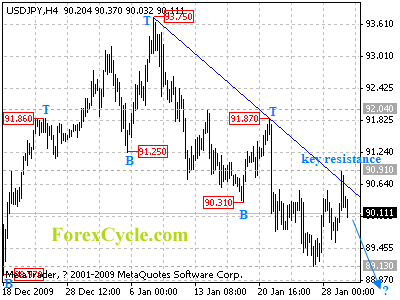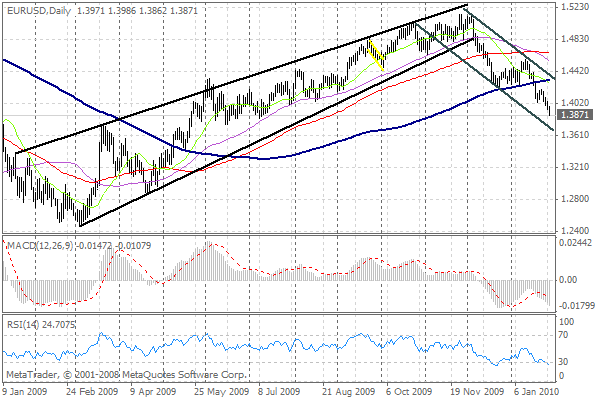By GCI Forex Research
Fundamental Outlook at 1500 GMT (EDT + 0500)
€
The euro depreciated vis-à-vis the U.S. dollar today as the single currency tested bids around the US$ 1.3900 figure and was capped around the $1.3985 level. The common currency slumped following stronger-than-expected U.S. economic data that were released today including a 5.7% q/q annualized climb in fourth quarter 2009 gross domestic product, up from the prior reading of +2.2%. The GDP price index was up less-than-expected at +0.6% while core personal consumption expenditures were up +1.4% q/q with the employment cost index up +0.5%. Also, the Chicago Purchasing Managers index rallied to 61.5 from the prior reading of 58.7 and the final January University of Michigan consumer sentiment indicator improved to 74.4 from the prior reading of 72.8. Generally speaking, today’s economic data were quite strong and evidenced a U.S. economy that remains in a jobless economic recovery for now. Employment aggregates continue to lag growth and activity data and most economists believe unemployment will moderate in 2010. Federal Reserve Chairman Bernanke was reconfirmed to a second term at the helm of the Fed yesterday and Treasury Secretary Geithner remains under political attack from both sides of the aisle. In eurozone news, EMU-16 unemployment escalated to 10% in December for the first time since the adoption of the euro in 1999. Also, EMU-16 lending to the private sector stalled last month and financing constraints will likely have a negative impact on economic growth. Additionally, EMU-16 inflation reached an eleven-month high last month and the December M3 money supply contracted 0.2%. The common currency continues to weaken partially on account of escalating sovereign credit concerns in the eurozone. Greek fiscal problems are being compounded by a similar situation in Portugal, Spain, Ireland, and elsewhere and there is ongoing chatter that the European Union may be forced to bail Greece out of its problems, despite strong German opposition. Euro bids are cited around the US$ 1.3740 level.
¥/ CNY
The yen depreciated vis-à-vis the U.S. dollar today as the greenback tested offers around the ¥90.90 level and was supported around the ¥89.60 level. Many data were released in Japan overnight. First, December core consumer prices were off 1.3% y/y, in line with expectations, and these data evidence Japan’s ongoing bout with moderate deflationary pressures. The government continues to pressure Bank of Japan to enact more monetary easing policies and these may eventually include more purchases of Japanese government bonds and more emergency lending plans. Other data released today saw December overall housing starts off 15.7% y/y while December construction orders were up +0.6% y/y. The Nikkei 225 stock index lost 2.18% to close at ¥10,198.04. U.S. dollar offers are cited around the ¥94.75 level. The euro moved higher vis-à-vis the yen as the single currency tested offers around the ¥126.65 level and was supported around the ¥124.80 level. The British pound moved higher vis-à-vis the yen as sterling tested offers around the ¥146.20 level while the Swiss franc moved higher vis-à-vis the yen and tested offers around the ¥86.40 level. In Chinese news, the U.S. dollar depreciated vis-à-vis the Chinese yuan as the greenback closed at CNY 6.8267 in the over-the-counter market, down from CNY 6.8268. People’s Bank of China Deputy Governor Zhu yesterday reported the U.S. carry trade is dangerous to the global economy and added China will continue to pursue a stable yuan. China will likely feel a lot of pressure from Group of Eight officials convening in Canada in early February regarding China’s exchange rate. PBoC reported Chinese property prices are up 21% from 2007’s levels and said corporate inventory growth is now decelerating. PBoC also indicated managing the economy has become “more difficult” and said it will pursue “reasonable and sufficient” credit and money controls.
₤
The British pound moved lower vis-à-vis the U.S. dollar today as cable tested bids around the US$ 1.6020 level and was capped around the $1.6180 level. Data released in the U.K. today saw January Nationwide house prices up 1.2% m/m and 8.6% y/y. U.K. Chancellor of the Exchequer Darling yesterday said reform that has already been agreed-upon should be implemented. Darling added the U.K. economic is “moving in the right direction”. Bank of England today announced it is abandoning its temporary swap lines with the Federal Reserve and said it has ended its asset purchase program of gilts. Sterling picked up ground yesterday on comments from Bank of England Monetary Policy Committee member Sentance who said it will be difficult to keep inflation on target given sterling’s depreciation. He also said data suggests the U.K. economy expanded more in Q4 than reported at +0.1%. Tory leader Cameron today called for more powers to be given to Bank of England to oversee the economy. Cable bids are cited around the US$ 1.5910 level. The euro moved higher vis-à-vis the British pound as the single currency tested offers around the ₤0.8690 level and was supported around the ₤0.8630 level.
CHF
The Swiss franc depreciated vis-à-vis the U.S. dollar today as the greenback tested offers around the CHF 1.0550 level and was supported around the CHF 1.0480 level. Data released in the U.S. today saw the January KOF leading indicator improve to +1.77 from +1.68 in December. Swiss National Bank President Hildebrand spoke today and said the central bank continues to sell assets from the UBS Stability Fund and that he remains optimistic on the process. Finace minister Merz indicated he is “happy” with the euro/ franc exchange rate. The euro came off vis-à-vis the Swiss franc as the single currency tested bids around the CHF 1.4645 level while the British pound depreciated vis-à-vis the Swiss franc and tested bids around the CHF 1.6870 level.
Forex Daily Market Commentary provided by GCI Financial Ltd.
GCI Financial Ltd (”GCI”) is a regulated securities and commodities trading firm, specializing in online Foreign Exchange (”Forex”) brokerage. GCI executes billions of dollars per month in foreign exchange transactions alone. In addition to Forex, GCI is a primary market maker in Contracts for Difference (”CFDs”) on shares, indices and futures, and offers one of the fastest growing online CFD trading services. GCI has over 10,000 clients worldwide, including individual traders, institutions, and money managers. GCI provides an advanced, secure, and comprehensive online trading system. Client funds are insured and held in a separate customer account. In addition, GCI Financial Ltd maintains Net Capital in excess of minimum regulatory requirements.
DISCLAIMER: GCI’s Daily Market Commentary is provided for informational purposes only. The information contained in these reports is gathered from reputable news sources and is not intended to be U.S.ed as investment advice. GCI assumes no responsibility or liability from gains or losses incurred by the information herein contained.








